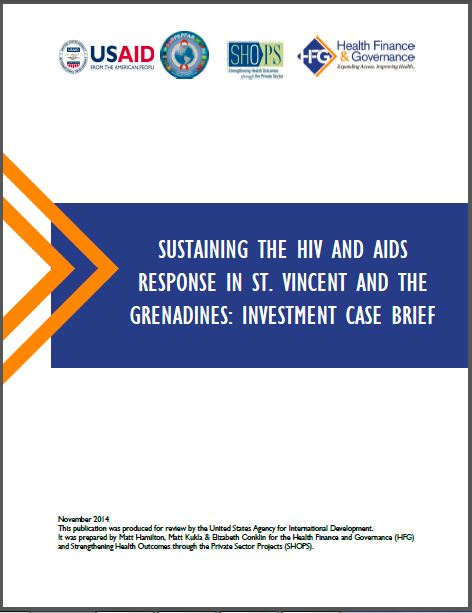Sustaining the HIV and AIDS Response in St. Vincent and the Grenadines: Investment Case Brief
Categories: HIV/AIDS, Home Page Map, Publications
Resource Type: Report
Authors: Matt Hamilton, Matt Kukla, Elizabeth Conklin
Published: November 2014
Resource Description:
 National surveillance reports estimate that there were about 649 persons living with HIV in St. Vincent and the Grenadines at the end of 2011, which translates to 1.2% of the adult population (15-49 years) or 0.7% of the total population. The epidemic is male-dominant, illustrated by the fact that the cumulative case reporting from 1984-2013 indicates that 60.6% of new cases are reported among males and 38.1% females (1.3% unknown). In response to the growing epidemic, the country quickly scaled up its national HIV/AIDS program in 2004. While care and treatment remains a high priority, St. Vincent and the Grenadines has devoted significant resources to preventative activities, including HIV counseling and rapid testing, education and workplace programs, and other behavioral interventions.
National surveillance reports estimate that there were about 649 persons living with HIV in St. Vincent and the Grenadines at the end of 2011, which translates to 1.2% of the adult population (15-49 years) or 0.7% of the total population. The epidemic is male-dominant, illustrated by the fact that the cumulative case reporting from 1984-2013 indicates that 60.6% of new cases are reported among males and 38.1% females (1.3% unknown). In response to the growing epidemic, the country quickly scaled up its national HIV/AIDS program in 2004. While care and treatment remains a high priority, St. Vincent and the Grenadines has devoted significant resources to preventative activities, including HIV counseling and rapid testing, education and workplace programs, and other behavioral interventions.
Despite a marked decline in HIV and AIDS cases, significant challenges for the country’s response remain. Close to 20% of persons with advanced HIV infection discontinue treatment within 12 months of initiation, suggesting the need to reinforce adherence and retention to care. The country also faces an imminent decline in donor funding and domestic reprioritization of chronic and non-communicable diseases; without renewed sources of external funding or greater domestic resources allocated to HIV/AIDS, progress made since 2004 could regress.
In response to these challenges, key priorities outlined in the country’s strategic framework (2014-2025) include: 1) institutionalizing HIV education through collaborative programs with different sectors, 2) targeting high risk groups, 3) strengthening HIV testing and counseling, including routine testing for pregnant women and, 4) ensuring access and retention to care and treatment for those with HIV and AIDS and TB. St. Vincent and the Grenadines has also taken steps to integrate HIV and AIDS services into the broader health system and included the HIV and AIDS program as part of the Ministry of Health, Environment and Wellness’ overall health framework. These actions are the beginning of efforts to improve access to care, reduce costs, and improve efficiencies.
Download



